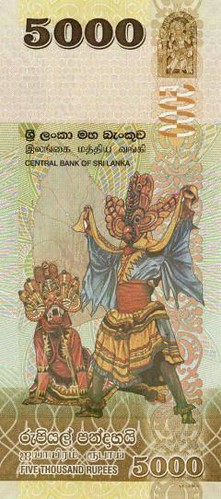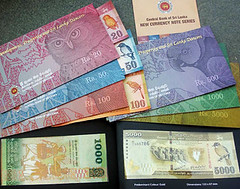
PREV ARTICLE
NEXT ARTICLE
FULL ISSUE
PREV FULL ISSUE
SRI LANKA ISSUES NEW BANKNOTES
Kavan Ratnatunga submitted these links to articles relating to Sri Lanka's new banknotes. Thanks!
-Editor
My article on them appeared in the Sunday Times of Sri Lanka.
Here's an excerpt from Kavan's article.
-Editor
The Central Bank of Sri Lanka (CBSL) issued a new set of six currency notes into circulation on February 7 which will replace the current notes in circulation that were first issued in 1991. The new set includes a new Rs 5000 note. Images of the notes had been published in the local newspapers on January 28 and online on the CBSL website. The notes have the date 2010-01-01 since the new notes were originally expected to be released at the CBSL 60th Anniversary celebrations in August 2010. The CBSL then announced that the notes would be released to the public at the Deyata Kirula exhibition which opened in Buttala on February 4. However lack of sufficient security at the temporary exhibition stall prevented that early release. They were only presented to President Mahinda Rajapaksa on Independence day.
The colours are close but not exactly the same as the older notes. The Rs. 20 note, for example is more pink and the Rs. 1000 a lighter green. The Rs. 500 has been made a distinct purple like the rare Rs. 5 notes of 1952 -a colour which was changed to red in the next issue of 1954. Most people I showed the notes to felt the older colours looked richer. I am very glad that the CBSL met the requests of collectors and for the first time issued sets of six notes with matching serial numbers in a colourful folder with a slip case. The price of Rs.7,500 included an extra Rs. 830 for the folder. The text is only in English. Individual folders are also available for each denomination where the text is in all three languages, Sinhala, Tamil and English. Costing from Rs. 150 to Rs 5,500, depending on the denomination, the full set of six individual folders cost Rs.8100. Only a 1000 of each has been made as collectors' items. The folder with all six notes seems to be more popular and had serial numbers in the 5000's. The six individual folders had serial numbers in the 6000's and I was lucky to get a set of them with the same serial number. Buying the folders has the additional advantage of getting low serial numbers which hold a numismatic premium. CBSL has also advertised an uncut sheet of 40 Rs100 notes, sold in a tube for protection. Uncut currency sheets are novelty collector's items overseas. The CBSL website says the paper used is 100% cotton fibre. It however feels very different to the older notes probably because of the printing. This paper appears to be more synthetic, the surface more polished. The public will take some time to get used to them. In the transition period while the older notes are withdrawn from circulation the smaller notes may get misplaced among the larger older notes.
To read the complete article, see:
Taking note of new notes
(http://www.sundaytimes.lk/110213/Plus/plus_05.html)
The Numismatic Bibliomania Society is a non-profit organization promoting numismatic literature. See our web site at coinbooks.org. To submit items for publication in The E-Sylum, write to the Editor at this address: whomren@gmail.com To subscribe go to: https://my.binhost.com/lists/listinfo/esylum All Rights Reserved. NBS Home Page Contact the NBS webmaster 
|

